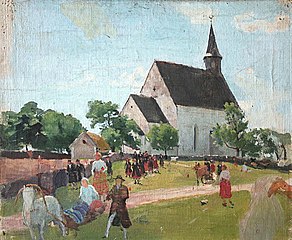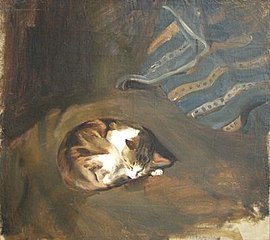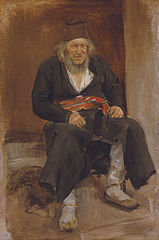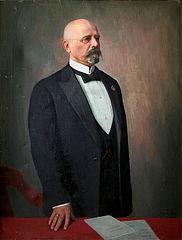art.wikisort.org - Artist
Paul Raud (22 October [O.S. 10 October] 1865 in Kirikuküla, Viru-Jaagupi Parish – 22 November 1930 in Tallinn) was an Estonian painter.
This article may be expanded with text translated from the corresponding article in Estonian. (July 2022) Click [show] for important translation instructions.
|
This article contains too many pictures that are sandwiching text or an indiscriminate collection of Image galleries for its overall length. |
Paul Raud | |
|---|---|
 Paul Raud, c. 1910 | |
| Born | October 22, 1865 Kirikuküla, present-day Estonia |
| Died | November 22, 1930 (aged 65) Tallinn, Estonia |
| Nationality | Estonian |
| Education | Kunstakademie Düsseldorf |
| Movement | Realism, Impressionism |
| Relatives | Kristjan Raud (twin brother) |
Life and works
The twin brother of painter Kristjan Raud, he studied at the Kunstakademie Düsseldorf beginning in 1886, becoming influenced by the work of Eduard von Gebhardt. He is associated with the Düsseldorf school of painting.
After his return to Estonia, he painted mainly portrait commissions for some time, before traveling with his brother and Amandus Adamson to the islands of Muhu and Pakri in 1896. His works of this period are reminiscent of those of Max Liebermann.
In 1899 he returned to work in Germany, taking on some of the stylistic trappings of Impressionism; this, coupled with time spent working with Ilya Repin, influenced his later style. Later in his career, most especially during and after World War I, he began to teach, from 1915 working as a drawing instructor at the Tallinn Institute of Commerce and from 1923 at the State School of Industrial Art in Tallinn.
Paul Raud is represented with works in the Art Museum of Estonia, Tallinn.
Gallery
- Semi-nude (1893)
- At the Rakvere Cemetery (1895)
- Muhu Church (1898)
- Self-Portrait with a Hat (1900)
- Sleeping cat (1908)
- A Road in a Park (1910)
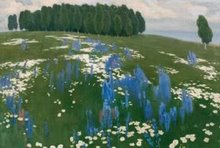 Field of flowers (1906–1911)
Field of flowers (1906–1911)- An Old Man from Muhu Island (1911)
- Half Nude (1911)
- Man in Military Uniform (c. 1911)
- Portrait of Jaan Poska (1929)
External links
- "From one Century to the Next: Exhibition of works by Kristjan and Paul Raud in Kumu Art Museum June 22–October 8, 2006[permanent dead link], information folder from the Art Museum of Estonia
- Works by Paul Raud at the Art Museum of Estonia
References
- Biography from answers.com
На других языках
[de] Paul Raud
Paul Raud (* 11. Oktoberjul. / 23. Oktober 1865greg.[1] im Dorf Kirikuküla, damals Kirchspiel Sankt-Jakobi; † 22. November 1930 in Tallinn) war ein estnischer Maler. Zusammen mit seinem Zwillingsbruder Kristjan und Ants Laikmaa gilt er als einer der einflussreichsten Künstler seines Landes zu Beginn des 20. Jahrhunderts.- [en] Paul Raud
[it] Paul Raud
Paul Raud (Kirikuküla, 22 ottobre 1865 – Tallinn, 22 novembre 1930) è stato un pittore estone, fratello gemello del pittore Kristjan Raud.[ru] Рауд, Пауль
Пауль Рауд (эст. Paul Raud; 22 октября 1865 (1865-10-22), д. Кирику, Валкский уезд, Лифляндская губерния, Российская империя — 22 ноября 1930, Таллин, Эстония) — эстонский художник.Другой контент может иметь иную лицензию. Перед использованием материалов сайта WikiSort.org внимательно изучите правила лицензирования конкретных элементов наполнения сайта.
WikiSort.org - проект по пересортировке и дополнению контента Википедии


